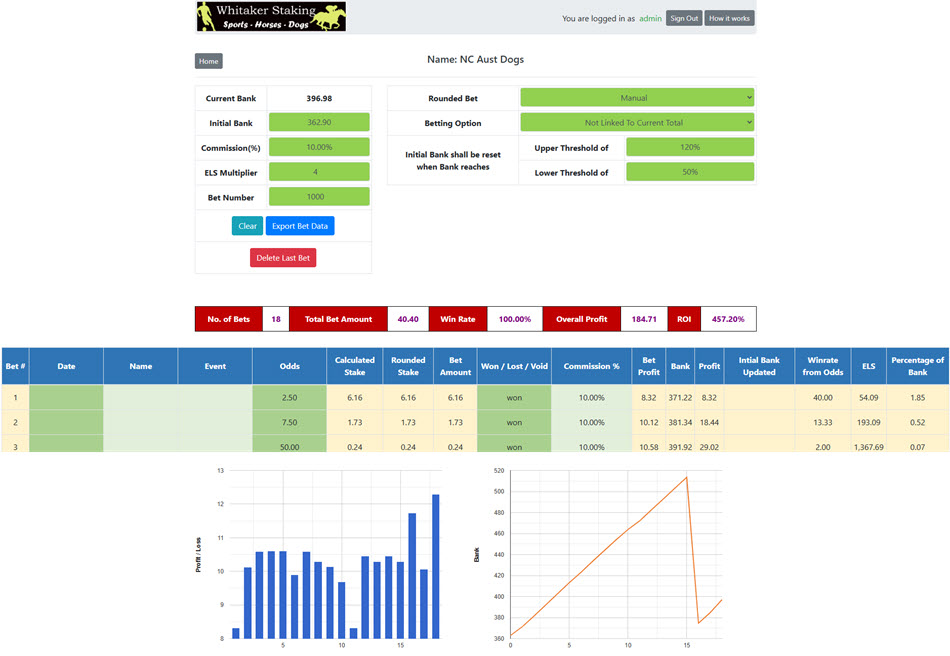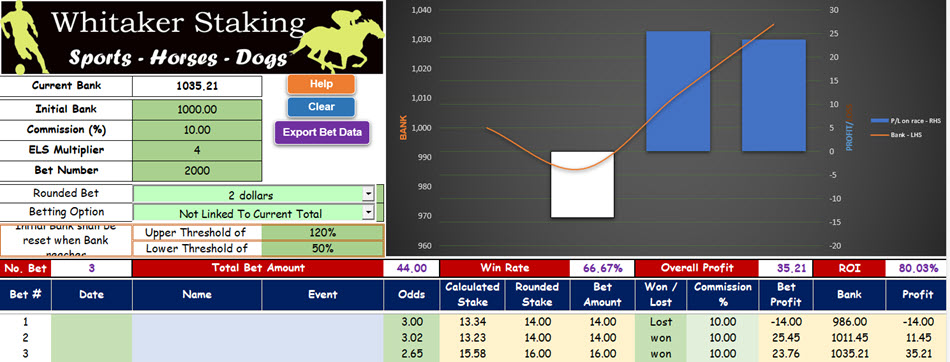
Tom's Quest to find the BEST STAKING..
32 stakings reviewed in his ebook.
Not Happy after the release more study and the ELS addition added
to the ebook, now a whopping 333 pages.
Whitaker Staking is probably the best staking plan ever.
It balances risk to reward in the most innovative way.
Don’t have any past bet data to test your system on? No problem, Whitaker Staking doesn’t need it.
Don’t know your average win rate? No problem, Whitaker Staking doesn’t need it.
Don’t know the volatility of your strategy? No problem. Whitaker Staking can handle it.
Want to bet on a mix of sports with one bank? No problem. Whitaker Staking can handle it.
Whitaker staking only needs to know ONE thing – the odds of your next bet.
If you don’t know what Whitaker Staking is, then get the ebook The Staking Plans Book and find out! It will change your betting mentality forever! Tom Whitaker researched 33 staking plans in his mammoth 333-page book to find the characteristics of the best staking plans for different kinds of betting strategies and put them together into this perfect staking plan.
This is THE definitive guide to staking plans for sports betting. You can buy The Staking Plans Book as a set with the Whitaker Staking spreadsheet packages if don’t have it yet.
If you already know what Whitaker Staking is, then you will be interested in these betting tools that will make things easier for you to use Whitaker Staking in your betting.
5-year license for Cloud Spreadsheet £29.97 - Just 50p a month to get a powerful betting tool in your pocket or PC!
You can use this one on your phone, tablet or PC.


Whitaker Staking Excel Spreadsheet
Does the same as the cloud spreadsheet but you get it as an Excel file you keep on your PC.
(You must have Microsoft Excel 2007 or better. No clone spreadsheet software will work this spreadsheet.)

What is Whitaker Staking?
Whitaker Staking is a method where each bet is placed at a percentage of the bank that is relative to its odds implied expected drawdown as calculated by the number of Expected Losing Sequences (ELS) we want the bank to survive over a specific number of bets.
Whitaker staking adjusts stake size based on the odds levels of each individual bet. It bets more on lower odds and less on higher odds. Lower odds bets tend to have higher win rates, and thus shorter losing runs which leads to less volatility in the short run. Higher odds bets tend to have lower win rates, and thus longer losing runs, which leads to more volatility in the short run. It aims to be the most advanced staking plan ever made.
The stake percentage is calculated based on an Expected Losing Sequence (ELS) multiple and the number of bets to be considered.
The ELS tells us the statistically expected number of times a bet at specified odds is likely to lose in a continuous unbroken streak for a set number of tries based on its odds implied probability of occurring.
For example, a 50-50 coin toss with odds of 2.00 has an ELS of 1 for 2 tries, so it would be statistically normal (neither lucky nor unlucky) for 1 of the 2 coin tosses to be a loser, but not impossible for both to lose in a row. But a 50-50 coin toss with odds of 2.00 has an ELS of 10 after 1000 tries.
It would be statistically normal (neither lucky nor unlucky) for 10 of the 1000 coin tosses to lose in a row. Any betting system based on such bets should plan that 10 losses in a row are expected to come, and the staking plan should be able to handle that. A 50-50 coin toss with odds of 2.00 has an ELS of 13 after 10000 tries. It is the law of numbers that the more we do something, the more chance of larger extremes occurring.
Most bettors are not concerned with the length of losing sequences, but the maximum drawdown a betting system might have from cumulative losing sequences. The staking plan should be able to help the bank survive those drawdowns without going bankrupt and still be able to move forward and make meaningful profit. We can estimate the drawdowns of a betting system as a multiple of its ELS. Drawdowns are basically the equivalent of several ELSs happening close to each other. We just need to decide how many ELSs we want the bank to be able to survive. Whitaker Staking’s default settings are to survive four ELSs over a 1000 bet period, but we can adjust the settings to be more or less aggressive. A higher ELS calculated over a longer bet period will be more conservative, a lower ELS calculated over a shorter bet period will be more aggressive.
Its creator, Tom Whitaker, compared the ELSs and maximum historical drawdowns of 743 betting strategies, many of them with over 5,000 bets of data going back 12 years. The result was that 83% of those strategies had drawdowns that were their ELSs of less than 4. This is why he chose the ELSx4 as the default setting. If a higher ELS multiple is chosen, then it covers even more volatile strategies, but as the ELS multiplier increases, the stake size decreases and the betting bank may be getting used less efficiently just to protect against the absolute worst-case scenarios. It is a risk-reward balance.
MDD/ELS Ratio |
Number of Strategies |
% of Strategies |
ELS Multiple for Whitaker Staking |
% of Strategies Covered in Total |
0.00 – 1.00 |
72 |
10% |
1 |
10% |
1.01 – 2.00 |
217 |
29% |
2 |
39% |
2.01 – 3.00 |
217 |
29% |
3 |
68% |
3.01 – 4.00 |
114 |
15% |
4 |
83% |
4.01 – 5.00 |
59 |
8% |
5 |
91% |
5.01 – 6.00 |
32 |
4% |
6 |
95% |
6.01 – 7.00 |
11 |
1% |
7 |
96% |
7.01 – 8.00 |
6 |
<1% |
8 |
97% |
8.01 – 9.00 |
7 |
<1% |
9 |
98% |
9.01 – 10.00 |
3 |
<1% |
10 |
99% |
10.01+ |
5 |
<1% |
11+ |
100% |
|
743 |
|
|
|
For example, if we wanted to bet on those 1000 coin tosses without going bankrupt, we might look at the ELS of 10 and decide we want to survive four ELSs. Four ELSs of 10 makes a maximum expected drawdown of -40 units. (4 x 10 = 40).
If we have a 100-point bank, then we would divide that by 40 to get 2.5. So we can plan that by betting 2.5 points per coin-toss, we think our bank can survive the statistically expected drawdown that is perfectly likely to happen over the next 1000 bets.
We think this should work for 83% of betting strategies. If we wanted to be more conservative, we could try to survive 6 ELSs which we think will work for 95% of betting strategies. An ELSx6 for odds of 2.00 over 1000 bets would be -60 units. Then we divided a 100 point bank by 60 to get 1.66.
So we can plan that by betting 1.66 points on each coin toss, we think our bank is capable of avoiding bankruptcy in 95% of situations. But stake sizes are lower, so we might be being inefficient with our bank.
The stake size is calculated for each individual bet based on its odds.
For example, if we set an ELS multiple of 4 for a 1000 bet period, the stake levels will be as below:
Odds |
Stake as % of bank |
Profit Target as % of bank |
1.50 |
3.98% |
1.99% |
2.00 |
2.51% |
2.51% |
2.50 |
1.85% |
2.77% |
3.00 |
1.47% |
2.93% |
4.00 |
1.04% |
3.12% |
8.00 |
0.48% |
3.38% |
20.00 |
0.19% |
3.53% |
These all seem like very sensible numbers.
You can read more detail about how this staking plan was researched and the logic behind it in the 333 page The Staking Plans Book.
Whitaker Staking Spreadsheet Pricelist.
5-year license for Cloud Spreadsheet £29.97
5-year license for Cloud Spreadsheet and The Staking Plans Book PDF for £39.94
Excel file and The Staking Plans Book PDF for £39.97

The Staking Plans PDF file only for £19.97
ONLINE VERSION |
Online Version Only.
UK PoundsNormally
|
eBook & Spreadsheet |
Excel Spreadsheet Only.
Licenced to 1 Computer only UK Pounds
|
If you don't accept this offer where will you be with your punting in a month from now? 2020-24 © Steve Davidson © 2020-24 Refund Policy We, as a merchant, provide both products (goods) and services (information) to our customers. If merchandise or products are ordered through a Direct Mail advertisement or via the Internet, the guarantee, if any, is included in the mailing, promotion or service description. Our advertising will also include the terms and conditions for refunds on any books, publications and/or systems purchased. |
Cheers
Steve Davidson





